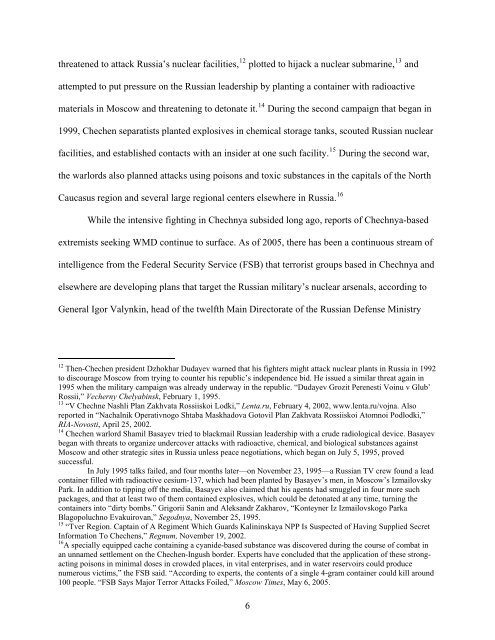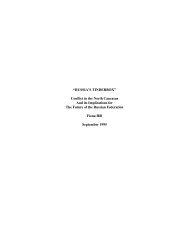Disrupting Escalation Of Terror In Russia To Prevent - Belfer Center ...
Disrupting Escalation Of Terror In Russia To Prevent - Belfer Center ...
Disrupting Escalation Of Terror In Russia To Prevent - Belfer Center ...
You also want an ePaper? Increase the reach of your titles
YUMPU automatically turns print PDFs into web optimized ePapers that Google loves.
threatened to attack <strong>Russia</strong>’s nuclear facilities, 12 plotted to hijack a nuclear submarine, 13 and<br />
attempted to put pressure on the <strong>Russia</strong>n leadership by planting a container with radioactive<br />
materials in Moscow and threatening to detonate it. 14 During the second campaign that began in<br />
1999, Chechen separatists planted explosives in chemical storage tanks, scouted <strong>Russia</strong>n nuclear<br />
facilities, and established contacts with an insider at one such facility. 15 During the second war,<br />
the warlords also planned attacks using poisons and toxic substances in the capitals of the North<br />
Caucasus region and several large regional centers elsewhere in <strong>Russia</strong>. 16<br />
While the intensive fighting in Chechnya subsided long ago, reports of Chechnya-based<br />
extremists seeking WMD continue to surface. As of 2005, there has been a continuous stream of<br />
intelligence from the Federal Security Service (FSB) that terrorist groups based in Chechnya and<br />
elsewhere are developing plans that target the <strong>Russia</strong>n military’s nuclear arsenals, according to<br />
General Igor Valynkin, head of the twelfth Main Directorate of the <strong>Russia</strong>n Defense Ministry<br />
12 Then-Chechen president Dzhokhar Dudayev warned that his fighters might attack nuclear plants in <strong>Russia</strong> in 1992<br />
to discourage Moscow from trying to counter his republic’s independence bid. He issued a similar threat again in<br />
1995 when the military campaign was already underway in the republic. “Dudayev Grozit Perenesti Voinu v Glub’<br />
Rossii,” Vecherny Chelyabinsk, February 1, 1995.<br />
13 “V Chechne Nashli Plan Zakhvata Rossiiskoi Lodki,” Lenta.ru, February 4, 2002, www.lenta.ru/vojna. Also<br />
reported in “Nachalnik Operativnogo Shtaba Maskhadova Gotovil Plan Zakhvata Rossiiskoi Atomnoi Podlodki,”<br />
RIA-Novosti, April 25, 2002.<br />
14 Chechen warlord Shamil Basayev tried to blackmail <strong>Russia</strong>n leadership with a crude radiological device. Basayev<br />
began with threats to organize undercover attacks with radioactive, chemical, and biological substances against<br />
Moscow and other strategic sites in <strong>Russia</strong> unless peace negotiations, which began on July 5, 1995, proved<br />
successful.<br />
<strong>In</strong> July 1995 talks failed, and four months later—on November 23, 1995—a <strong>Russia</strong>n TV crew found a lead<br />
container filled with radioactive cesium-137, which had been planted by Basayev’s men, in Moscow’s Izmailovsky<br />
Park. <strong>In</strong> addition to tipping off the media, Basayev also claimed that his agents had smuggled in four more such<br />
packages, and that at least two of them contained explosives, which could be detonated at any time, turning the<br />
containers into “dirty bombs.” Grigorii Sanin and Aleksandr Zakharov, “Konteyner Iz Izmailovskogo Parka<br />
Blagopoluchno Evakuirovan,” Segodnya, November 25, 1995.<br />
15 “Tver Region. Captain of A Regiment Which Guards Kalininskaya NPP Is Suspected of Having Supplied Secret<br />
<strong>In</strong>formation <strong>To</strong> Chechens,” Regnum, November 19, 2002.<br />
16 A specially equipped cache containing a cyanide-based substance was discovered during the course of combat in<br />
an unnamed settlement on the Chechen-<strong>In</strong>gush border. Experts have concluded that the application of these strongacting<br />
poisons in minimal doses in crowded places, in vital enterprises, and in water reservoirs could produce<br />
numerous victims,” the FSB said. “According to experts, the contents of a single 4-gram container could kill around<br />
100 people. “FSB Says Major <strong>Terror</strong> Attacks Foiled,” Moscow Times, May 6, 2005.<br />
6
















